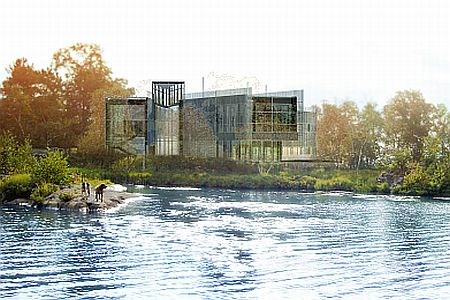With the final portion of its $20.2 million capital budget finally in hand, the Vale Inco Living With Lakes Centre is ready to begin construction after seven years of endless lobbying, planning and redesigning.
The late-May announcement of $5 million in support from Industry Canada's Knowledge Infrastructure Program cemented the project's last funding gap. A letter of intent has been signed with Tribury Construction to become the primary contractor for the project, with the contract expected to be ratified in the coming weeks.
This paves the way for shovels to hit the ground by mid-July 2009, while the structure should be visible by the fall of this year. The enclosure of the facility will be done by spring 2010, with an expected completion date of winter 2011.
"This isn't a business-as-usual type of building, and it's been a long seven years to get here," says John Gunn, a Canada Research Chair in Stressed Aquatic Systems at Laurentian University, and who helped conceive the idea of the LEED-platinum centre.
"We started out with some very practical goals, and now we're finally where we were hoping to be."
The 26,000-square-foot site represents a new home for Laurentian's growing Cooperative Freshwater Ecology Unit, and will house applied research in environmental restoration and sustainability.
The project is also targeting LEED Platinum certification, meaning officials must be careful about how the construction process is conducted.
This places restrictions on how such as matters as how much material goes to landfill, and the level of waste in new materials used in construction.
The amount of regionally-derived materials are also a factor, and the building process will therefore include wood and stone from Northern Ontario, including the limestone to be used as a bed under perforated pavement, which will filter metals from acid rain.
The systems to be used in the finished product are also key to the prestigious LEED Platinum certification, and the Living With Lakes Centre is no exception. The design calls for the use of geothermal heating, wherein summer heat will be stored in the underlying rocks, and will be extracted in the winter months through radiant flooring.
This would be the most northern use of the technology in North America, allowing Living With Lakes to link with 16 universities across the continent who will use the building to help establish better building codes.
Other features include the use of a "green roof," where the top of the facility will have vegetation cover of blueberries.
These efforts also have a practical effect, drastically lowering its overall operating costs.
All told, the centre will have 77 per cent less energy use and 80 per cent less water use than a traditional building. The heating and lighting budget will drop to less than $40,000 annually for the site.
These elements earned the design international accolades last fall when the Swiss-based Holcim Foundation for Sustainable Construction gave it third place in its North American awards.
"We didn't start off wanting to be a green design showcase," says Gunn. "We went there because we couldn't afford to inherit a building that we couldn't afford to operate in."
While the immediate job impact isn't clear, the new facility is expected to begin attracting new projects "very quickly," with up to 40 new positions to be created within five years in research chairs, technical expertise and professorships.




